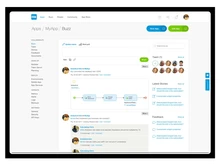Mendix and OutSystems are two well-known low-code development platforms available in the market. Several key aspects come into the picture when we compare these two platforms. These include user interface design, integration capabilities, mobile app development, scalability, feature sets, ease of use, pricing, speed, community support, documentation, and more. By understanding these factors, businesses and developers can gain insights into the strengths and key differentiators of these platforms. This helps them make informed decisions based on their specific project requirements and organizational objectives.
Mendix vs. OutSystems: An Overview
Mendix is a low code application development platform that helps businesses create, iterate, as well as deploy applications at a rapid scale. It offers some advanced-level visual development tools and model-driven logic, to enable users to build enterprise-grade applications with minimal coding. This helps accelerate digital innovation and enables collaboration between businesses and IT teams.
OutSystems, on the other hand, is a leading low-code application development platform designed to accelerate the delivery of enterprise applications. It allows organizations to create, deploy, and manage different applications across various channels, with features for integration and scalability, and robust deployment options. Apart from that, OutSystems empowers developers to build secure, scalable, resilient applications while facilitating collaboration between IT and business teams.
Mendix vs. OutSystems: Key Differences
Here are some major key differences between Mendix and OutSystems in the pointers below:
- Mendix and other Mendix alternatives offer a visually driven, model-driven approach to UI design with drag-and-drop capabilities, while OutSystems provides a visual modeling environment with drag-and-drop features.
- Mendix supports cross-platform mobile app development with native capabilities, while OutSystems and a few OutSystems alternatives offer offline support for mobile application development.
- The flexibility of vendor lock-in and licensing models varies between Mendix and OutSystems. This impacts how users can export application code and data.
- Mendix and OutSystems both offer cloud-based as well as on-premises deployment options, but OutSystems majorly relies on cloud-based deployment.
Mendix and OutSystems: In Terms of Features
Below are some of the major differences between Mendix and OutSystems based on their features and functionalities. These include:
- Application Integration: Mendix provides seamless integration with multiple enterprise systems and databases through its built-in integration for REST and SOAP services. On the other hand, OutSystems offers integration with enterprise systems, databases, as well as external APIs. It supports REST, SOAP, as well as OData services.
- Mobile App Development: Mendix supports cross-platform mobile app development using its native functionalities through its mobile app development platform. Whereas OutSystems provides support for mobile app development with native capabilities as well as offline support for mobile applications.
- Language: Mendix uses a visual modeling environment and supports a variety of programming languages, including Java and JavaScript. OutSystems, on the other hand, uses its visual development language and platform based on .NET technology.
- Visual Modeling: Mendix offers a visually driven as well as model-driven approach to UI design with drag-and-drop capabilities and a wide range of pre-built UI components. On the other hand, OutSystems provides a visual modeling environment for UI design with drag-and-drop features only.
Mendix and OutSystems: Scalability and Performance
Both Mendix and OutSystems are designed to be highly scalable and offer good performance. The scalability of applications built on these platforms depends on the underlying infrastructure and deployment configurations.
Mendix or OutSystems: Architecture, Setup, and Interface
Mendix uses a multi-tenant cloud architecture and offers options for on-premises deployment. The setup is facilitated by a web-based interface for application development. Whereas OutSystems follows a multi-tenant cloud architecture and supports on-premises deployment. Its setup is facilitated by a web-based interface with visual development tools.
Mendix and OutSystems: Pricing
Mendix’s pricing and licensing model is way more flexible than OutSystems. It caters to a wide range of organizations. On the other hand, OutSystems has a more structured pricing model that caters to the enterprise’s needs only.
Mendix vs. OutSystems: Learning Curve
Mendix is more user-friendly with a shorter learning curve, making it accessible to a broader range of users. On the other hand, OutSystems requires more training for users due to its specialized visual language.
Mendix or OutSystems: Scalability and Flexibility
Mendix is better known for its flexibility and ease of use. This enables rapid development of applications, while OutSystems is particularly known for its scalability as well as its ability to handle complex enterprise applications.
Mendix and OutSystems: Community Support
Both Mendix and OutSystems have active user communities and provide support through online forums, documentation, and customer support services. However, Mendix has a strong focus on community collaboration, while OutSystems emphasizes more on enterprise-level support.
Verdict: Mendix vs. OutSystems
Mendix and OutSystems are both leading low-code application development platforms, offering visually driven UI design, robust mobile app development support, and seamless integration capabilities. While Mendix emphasizes cross-platform mobile app development and extensive customization, OutSystems is known for its comprehensive integration support and pricing flexibility. Apart from that, the community support of Mendix is better than that of OutSystems. On the other hand, OutSystems is better at handling complex applications.


 4 Ratings & 1 Reviews
4 Ratings & 1 Reviews




















